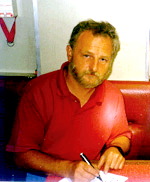 Equipping
the Yeoman Rose
Equipping
the Yeoman Rose Equipping
the Yeoman Rose
Equipping
the Yeoman Rose
(Note: The antenna needed to be suspended from both ends so that it was horizontal.
The Yeoman Rose, only having a foremast, had to be fitted with a tower near
the bridge to support the other end of the antenna. The Rose's original mast
also had to be 'extended' to match the height of the tower. Ed.)
The Build
By the time I arrived to join the ship, it was only four days before the scheduled
sailing. The tower that I had found earlier in the year for us to use, lay on
the quayside at Queenborough. The ship's owner had organised generators, extra
water supplies, crew and fuelling of the Yeoman Rose. The ship's sides were
being painted black. (Ray Anderson and Chris Elliot subsequently painted RADIO
LONDON 266 in huge white letters on the port side of the ship, by standing in
a dinghy! Only lack of time stopped them doing both sides. Anoraks through and
through! Ed.)
Caravans from a local site had been purchased and were due to arrive later that
day. These were to be lowered into the hold and used as on-board accommodation.
A local chandlery supplied the nylon rigging for the tower. Normally steel ropes
and insulators would be used, but I took the decision that for only 28 days,
man-made ropes would be cheaper and easier. (How right I was!)

By 4.30 in the afternoon, the telescopic tower was hanging from a massive crane
only inches from the deck. With the tower welded to the deck and with the help
of Paul and Les, (the other radio engineers), the tower was winched skywards.
We started work with the basic antenna structure. In the beginning, all that
was required was to elevate the basic bits of hardware and leave them to stretch
overnight. The ship's foremast needed to be extended by some nine metres. This,
however, posed no problem to Phil, (one of the skippers). He used a pulley at
the top to hold the antenna supporting-rope and eyes to take the extra rigging.
Now it was possible to erect the whole antenna to its full height.
Various tests were carried out, as well as many modifications! A good quantity
of inch-wide by about one-sixteenth-thick lightning conductor formed the ground-plane
which was to dangle over the side and extend like six 'tentacles'.
Technically, the aerial was limited (by the rules of the RSL) to a single vertical
radiator of a maximum length of ten metres. This posed a problem, as the theoretical
correct height to operate at the frequency of 1134 kHz (266 metres) should be
in the region of sixty-six metres! Essentially what was used was the previously-mentioned
ten-metre vertical, at the top of which was fixed a large coil as top-loading,
suspended below four parallel horizontal wires to act as a capacity hat. At
the bottom of the vertical radiator was another coil and capacitor network to
match to the low-impedance feed cable from the transmitter in the hold. Another
legal requirement was, naturally, the power output. Our restriction was only
1 Watt ERP (effective radiated power)! With such a small aerial the efficiency
would naturally be low.
Activities were also taking place in one of the ship's cabins. In what was
in fact the Skipper's, Ray and Les carefully demolished the internal furniture
with the exception of the bunk. The entire on-air studio was built in one day,
which included installing custom furniture and the majority of the technical
equipment.
The hired generator (a three-cylinder air-cooled Lister) was craned on board.
Paul set to running-in power to all the technical areas. Safety lighting in
the hold soon followed. A standby generator was also hauled aboard. This was
a two-cylinder version of the main generator, although very much older. What
seemed to be an endless supply of 45-gallon oil drums were loaded for the generator's
fuel.
The Yeoman Rose first lay at anchor one mile offshore and three-quarters of
a mile down from the pier end. (This position was later changed to half a mile
off both the beach and pier to make things safer for the tender). Programmes
were scheduled virtually from the beginning of the licence, therefore time was
extremely limited for transmitter tests into this strange 'miniature aerial'.
The final construction was not a perfect match. The transmitter we had intended
to use had protection devices that were too sensitive, with the result that
it shut down to protect itself. Les luckily had his standby transmitter on board.
This transmitter was far more tolerant and as all who heard Radio London will
know, it put out a brilliant signal without failure for the entire twenty-eight
days' broadcast.
Several attempts were made overnight to improve the aerial set-up, but the limited
daylight during the transmitter down time (after 2 am and back on air before
the first show of the day at 6 am) defeated us.